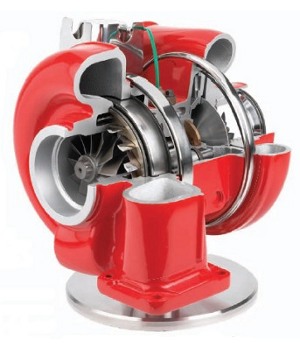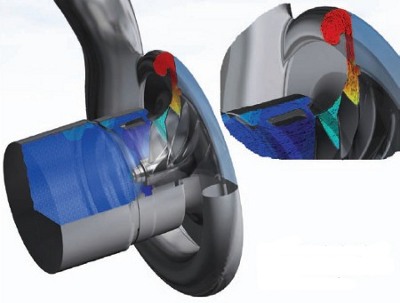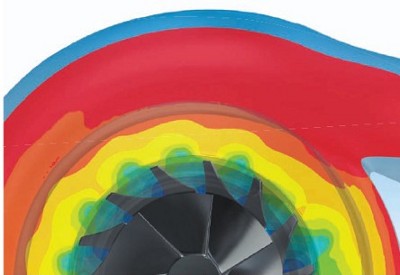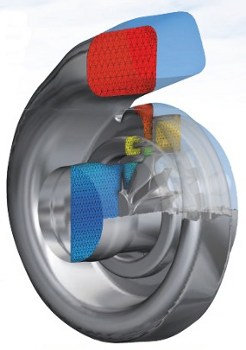 |
| March 06, 2012 | Volume 08 Issue 09 |
Designfax weekly eMagazine
Archives
Partners
Manufacturing Center
Product Spotlight
Modern Applications News
Metalworking Ideas For
Today's Job Shops
Tooling and Production
Strategies for large
metalworking plants
Wheels:
Cummins ramps up turbocharger design
Cummins uses high-performance computing to deliver better turbochargers to market – faster – by simulating the entire stage.
By John Horsley, Engineer, Air Handling, Cummins Turbo Technologies, Huddersfield, U.K.

A typical turbocharger supplied by Cummins Turbo Technologies.
As a developer of turbochargers, Cummins Turbo Technologies has wrestled with – and now resolved – running full-stage simulation to ultimately deliver a better product. The enormous size of turbocharger simulation models, averaging 8 million elements for the compressor stage and 12 million for the turbine stage, previously made it impossible to run full-stage simulations as part of the normal design process. ANSYS computational fluid dynamics (CFD) software plays a critical role in the design process by enabling Cummins engineers to evaluate a wide range of design alternatives to optimize performance prior to building a product or even a prototype. Cummins upgraded to a 160-node high-performance compute cluster to take full advantage of the software's near-linear parallel processing capabilities. The new high-performance computing (HPC) system has reduced solution times by a factor of 12, making it possible to routinely run full-stage simulations. As a result, Cummins has been able to improve turbocharger performance and reduce time to market.
Cummins Turbo Technologies produces turbochargers for diesel engines used in automotive, off-highway, power generation, and marine applications. Now a division of global power leader Cummins Inc., it was founded as Holset Engineering, producing a brand synonymous with turbocharging and air-flow management for the last five decades. Turbochargers from Cummins Turbo Technologies are found in medium- and heavy-duty diesel engines around the world.

Static pressure rise through the compressor stage as well as the level of mesh and flow detail provided by simulation.
In simple terms, a turbocharger comprises a turbine and compressor connected by a common shaft supported on a bearing system. The turbocharger compresses air flowing into the diesel engine. This enables the engine to squeeze more air into a cylinder so that more fuel can be added, which, in turn, increases the power of the engine.
In the past, Cummins designed turbochargers by going through multiple build-and-test hardware prototype cycles to verify performance, stress, and fatigue life. This process was very time consuming and expensive. When the company began converting to an analysis-led design strategy, Cummins Turbo Technologies selected ANSYS CFX software as its primary CFD tool because of its industry-leading technology for turbomachinery simulation. ANSYS CFX enables Cummins engineers to evaluate design concepts and variations virtually in a fraction of the time and cost required in the past using physical prototypes. While the data that can be captured from hardware prototypes is limited by sensor capabilities, CFD enables engineers to easily determine what is happening at any point in the computational domain. Simulation results show very good correlation with physical testing in the lab on the gas stand.

Interaction between volute and compressor wheel highlighting pressure variations around the vaneless diffuser.
One of the challenges in simulating turbochargers is the need to use extremely dense meshes to accurately represent the complex geometry and to capture the full flow features of today's advanced turbochargers. This, in turn, creates extremely large problems that require huge amounts of computing power to solve.
Cummins' previous generation of HPC included eight nodes of parallel computing capacity. Simulation of a full-stage compressor took between 36 and 48 hours, and a full-stage turbine simulation took between 60 and 72 hours. This was too long to keep pace with the design process, so engineers typically simulated only parts of the compressor or turbine stage, such as the turbine wheel, nozzle, or housing. Though these simulations were valuable, engineers felt that they could achieve their design objectives considerably faster if they were able to simulate the entire stage to better understand the interactions between the various turbocharger components.
To accomplish this goal, Cummins implemented a 160-node high-performance compute cluster running on the Linux operating system. Most CFD simulations at the company are run on 32 nodes, enabling five simulations to be run at one time. The new system has reduced simulation time by a factor of 12. A single run for a full-stage compressor now takes four hours, and a full-stage turbine simulation can be run in five to six hours. The improvement in performance is greater than linear: The new generation of hardware is more efficient, and recent improvements in the CFD software's parallel processing further reduce time.
The ability to run full-stage simulations while keeping pace with the design process provides insights that were not available in the past when simulating individual components. Engineers can gain a much better understanding of the interaction between the compressor wheel and the diffuser when simulating the entire system. For example, the compressor stage housing is asymmetrical, which results in a variable pressure distribution around the circumference of the compressor wheel. Engineers can now easily visualize how that pressure distribution affects compressor wheel performance.

Expansion of gas through a variable-geometry turbine stage and level of detail defined in the mesh used for simulation.
Using HPC provides Cummins engineers with enough detail in the simulation to fully understand design tradeoffs while obtaining results in a time frame that allows for maximum impact on the design process. HPC also enables engineers to increase mesh density to help improve accuracy of the simulation results. One area in which density is critical is the clearance path around the circumference of the compressor wheel, where air can leak out through tiny gaps. This area is difficult to design because the manufacturing process can introduce variations, causing the gaps to be bigger or smaller than the nominal design. HPC makes it possible to generate a mesh that is fine enough to accurately determine the impact of small variations in these gaps as well as other critical features. Engineers can then evaluate the full range of possible gap sizes to determine the impact of different manufacturing methods and tolerances.
Engineers at Cummins now use full-stage simulations to design new products, validate changes to existing products, and evaluate new technologies. They also evaluate many different compressor stage designs to see which one provides the best balance between efficiency, flow range, and pressure ratio. Customers of Cummins typically are seeking high efficiency, a wide flow range, and a specified pressure ratio. These constraints often conflict with each other: For instance, increasing pressure ratio generally reduces efficiency. Turbine design also requires dealing with many other tradeoffs. For example, the turbine wheel needs to match the flow range while providing the highest possible efficiency and meeting mechanical design constraints.
ANSYS HPC technology is enabling Cummins to use larger models with greater geometric details and more realistic treatment of physical phenomena to generate results in less time. Instead of spending months to build and test a physical prototype or days to simulate a design using their previous-generation HPC solution, Cummins engineers can now simultaneously evaluate up to five full-stage compressor or turbine designs in a few hours. Physical testing still plays a vital role in the design process, but the number of prototypes that have to be built and tested has been substantially reduced. Through extensive simulation, Cummins engineers are now usually able to get the design right the first time. The result is that Cummins can bring new products to market in less time while substantially reducing engineering expenses. The power of HPC has made it possible for Cummins to envision combining both turbine- and compressor-stage simulation with a full-engine simulation to optimize their designs to an even higher level.
SIDEBAR: HPC technology for large problems
ANSYS CFX software uses a single-program multiple-data (SPMD) parallel implementation, running identical versions of the code on multiple processors. The overall run procedure is divided into two steps: a partitioning step, in which the mesh is divided into partitions, and a solution step, with a solver process running for each mesh partition under the control of an overall master process. Special multi-pass partitioning is available when simulating coupled rotating and stationary components in turbomachinery applications to optimize the partitioning algorithm and, thereby, improve parallel performance. In general, the solver maximizes the parallelization of numerically intensive tasks and minimizes the serial tasks handled by the master process. Communication between processes during a parallel run is performed using the latest message-passage libraries, including Platform Computing MPI and Microsoft MPI. Solution scalability is excellent, showing near-linear speed-up in many cases.
Source: ANSYS
Published with permission from ANSYS Advantage • Volume V, Issue 2, 2011
Published February 2012
Rate this article
View our terms of use and privacy policy
